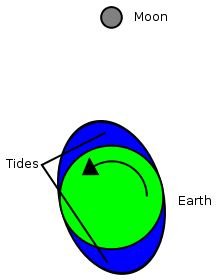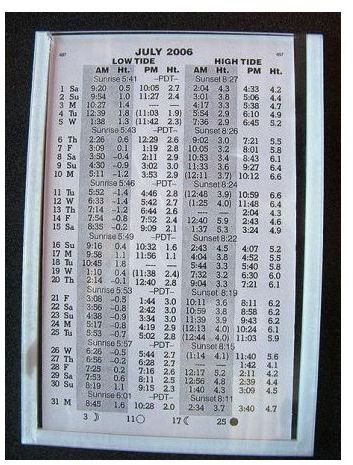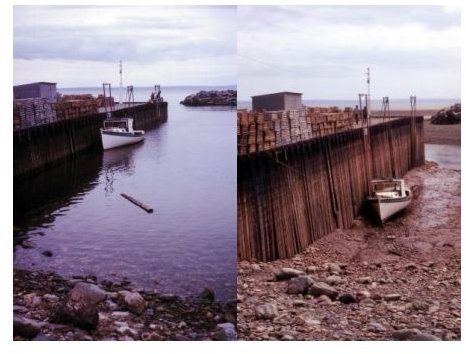How Does the Moon Affect the Ocean Tides?
What are Ocean Tides?
Tides are the regular pattern of rising and falling sea levels observed at coastlines all around the Earth. When the sea reaches its highest point, it is described as being at high tide; conversely, the sea’s lowest point is termed low tide.
The ocean tides are dominated by the gravitational effects of the Moon and, to a lesser extent, the Sun, with contributions from various other factors including the Earth’s rotation and tilt on its axis, the shape of shorelines and the depth of the ocean floor.
The influence of the Moon on the tides is demonstrated by the fact that most coastlines have two high tides and two low tides every lunar day with respect to the Earth. This is the time it takes for a spot on the Moon to return to its position over any particular spot on the Earth; because of its link with the ocean tides, it is also known as a tidal day. At 24 hours and 50 minutes, the lunar or tidal day is longer than an Earth day. As a consequence, the tides occur at different times each day, with pairs of high tides and low tides being 12 hours and 25 minutes apart.
Twice every month (at full moon and new moon), the high tide is higher than average; this is called a “spring tide”. The low tide is lower than average—a neap tide—around the time of the first and last quarter moons.
The height of tides can also be affected by weather conditions such as storms and atmospheric pressure, but these do not exhibit regular patterns.
The Moon’s Affect on the Ocean
Tides are largely due to the gravitational forces exerted by the Moon and Sun on the Earth, combined with their relative movements.
According to Newton’s Law of Universal Gravitation, every particle in the Universe attracts every other particle with a force proportional to the product of the two masses and inversely proportional to the square of the distance between them. This relationship means that, though the Sun is much more massive than the Moon, the Moon has a far greater effect on the Earth’s tides because it is very much closer.

At any time, the gravitational pull on the oceans is greatest on the side of the Earth that is facing the Moon. This causes a bulging of water towards the Moon, which is experienced as a high tide on Earth’s coastlines. Meanwhile, on the far side of the planet, there is a second bulge. Here, the gravitational pull of the Moon is less because it is further away; instead, forces due to the Earth’s rotation are dominant, and these cause a movement of the ocean away from the Moon.
As it rotates on its axis, the Earth passes under two bulges during every 24-hour period, which explains why there are two high and low tides each day. While the sides of the Earth facing towards and away from the Moon experience high tides, the two perpendicular sides are having low tides. Between these extremes, sea levels are rising or falling as the next tide approaches.

Similar bulges are generated by the Sun’s gravitational pull, but their effect is usually small compared with those produced by the Moon. The exception is when the Earth, Moon and Sun are aligned – as occurs twice every month during the full and new moons. At these times, the Sun’s pull is acting in the same direction as that of the Moon; the result is a larger bulge in the oceans, producing a spring tide. The opposite effect occurs during neap tides. At the time of the quarter moons, the Earth, Moon and Sun form a right angle, and so the Moon and Sun’s combined pull on the oceans is at a minimum.
Why Understanding Tides is Important
Our knowledge of how the Moon affects the ocean tides allows predictions to be made about the times and heights of high, low, spring and neap tides. This information is invaluable for a wide range of marine activities, including navigation, engineering projects such as the building of harbours and other offshore structures, commercial fishing, and even leisure pursuits like surfing and swimming. Without it, working and playing in coastal areas would be much more hazardous activities.
Image Credits
Bay of Fundy: Tttrung/Samuel Wantman, https://commons.wikimedia.org/wiki/File:Bay_of_Fundy.jpg
Ocean Bulges: Andrew Buck, https://commons.wikimedia.org/wiki/File:Tidal_braking.svg
Tide Table: Tewy, https://commons.wikimedia.org/wiki/File:Tide_table_01.jpg
References
- “Science: Lunar Months” http://www.hermit.org/eclipse/why_months.html (Accessed 17-10-11)
- “Our Restless Tides” http://tidesandcurrents.noaa.gov/restles1.html#Intro (Accessed 17-10-11)
- “Interplanetary Low Tide” http://science.nasa.gov/science-news/science-at-nasa/2000/ast04may_1m/ (Accessed 17-10-11)
- “Tides and Water Levels” http://oceanservice.noaa.gov/education/tutorial_tides/welcome.html (Accessed 17-10-11)
- “Questions & Answers About Tides” http://www.pol.ac.uk/home/insight/tidefaq.html (Accessed 17-10-11)
